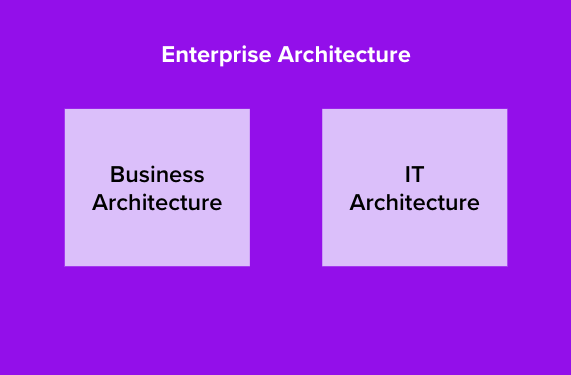As Enterprise Architecture continues to make great strides to refocus on people, processes, and value rather than primarily technology, the line between Enterprise Architect and Business Architect becomes increasingly unclear. In some organizations, Business Architects play very similar roles to Enterprise Architects, and in others, Business Architects maintain a distinctly separate strategic focus on the organization’s operations.
In this blog, we’ll delve into Business Architecture’s relationship with Enterprise Architecture and the role of Business Architects in the digital organizations of today.
Jump to:
- What Is a Business Architect?
- What's the Difference Between a Business Architect and an Enterprise Architect?
- What Tools Do Business Architects Use?
- What Makes a Successful Business Architect?
- How Ardoq Supports Business Architects
What Is a Business Architect?
Occupying a senior role in the organization, the Business Architect is a strategic thinker who bridges the gap between business strategy and its operational execution. The Business Architect possesses a deep understanding of the organization's goals, capabilities, and processes, and is responsible for overseeing critical deliverables such as business capability models and value streams.
As strategic partners, Business Architects ensure the organization's capabilities align with its goals to achieve the intended business outcomes. They are also guardians of the Business Architecture, a comprehensive blueprint that outlines the organization's core functions, processes, and information flows. Business Architects lead in the development of new multi-dimensional Business Architecture or in re-architecting aspects of existing ones.
What Is Business Architecture?
Business Architecture provides a holistic view of the organization, outlining the building blocks that enable it to deliver value. It considers not just the technological landscape but also the people, processes, and information that drive the organization forward.
Business Architect Myths and Misperceptions
There are some common misconceptions about Business Architects. They are not simply IT specialists or project managers. Business Architects have a broader focus, working across the organization to ensure business goals are met.
Among the common misconceptions about Business Architects, here are two key ones to dispel:
- Myth 1: Business Architects are business analysts with a different title. While Business Architects share some skills with business analysts, their focus is broader. They look at the big picture, ensuring alignment between strategy and execution across the entire organization.
- Myth 2: Business Architecture is only about IT. Business Architecture encompasses the entire organization, not just technology. It ensures that IT systems support and enable business capabilities.

What Does a Business Architect Do: Role and Responsibilities
Finding ways to bridge the gap between strategy and execution is key to the role of Business Architect. Achieving this requires wearing many hats, but the core Business Architect responsibilities fall under strategy alignment, process optimization, and IT enablement.
Besides identifying capabilities and opportunities for improvement, Business Architects play a crucial role in collaborating with IT teams to ensure technology solutions support and enable those capabilities and opportunities. The key Business Architect roles and responsibilities include:
- Understanding and translating business strategy: Business Architects analyze the organization's goals and objectives, translating them into actionable plans.
- Identifying and documenting business capabilities: They identify the key functions and processes that enable the organization to deliver value.
- Developing Business Architecture artifacts: These artifacts include capability maps, value stream models, and process flows, which visually represent the organization's structure and capabilities.
- Facilitating communication and collaboration: Business Architects bridge the gap between business and IT, ensuring clear communication and alignment.
- Recommending and guiding business change initiatives: By analyzing capabilities and processes, Business Architects identify areas for improvement and recommend change initiatives to optimize performance.
Business Architect Deliverables
The deliverables produced by Business Architects are crucial for organizational decision-making. Some key deliverables include:
Business Capability Models: These models map the organization's core functions, outlining how they contribute to achieving strategic objectives. This shared understanding allows for informed decisions about resource allocation and capability development.
Gap Analysis Reports: Business Architects analyze the current state of operations against the desired future state. These reports highlight discrepancies, allowing for targeted interventions to bridge the gap. This could involve process improvements, technology investments, or organizational restructuring.
Value Stream Maps: Value streams are visual representations that depict the flow of activities required to deliver products or services to customers. Business architects can optimize value streams for better performance and cost reduction by identifying bottlenecks and inefficiencies.
Business Architecture Roadmaps: These roadmaps chart a course for implementing the desired future state. They prioritize initiatives, define timelines, and outline dependencies, ensuring a clear path toward achieving strategic goals.
Communication and Alignment Plans: Business Architects don't operate in silos. They actively communicate their findings and recommendations to stakeholders across the organization. Clear communication plans ensure buy-in from senior leadership and IT teams, fostering alignment for successful execution.
The benefits created by these deliverables for organizations include:
Strategic Decision-Making: Business Architecture deliverables provide a data-driven foundation for strategic decisions. Executives gain a clear picture of capabilities, gaps, and value streams, enabling them to prioritize initiatives that maximize business value.
IT Alignment: Business Architecture fosters a shared understanding between business and IT. IT leaders can leverage these deliverables to align technology investments with business needs, ensuring a return on investment.
Improved Efficiency and Agility: Business Architecture helps identify and eliminate inefficiencies. Optimized value streams and streamlined processes lead to greater operational agility, allowing organizations to adapt quickly to changing market conditions.
What's the Difference Between a Business Architect and an Enterprise Architect?
While their roles can overlap, there's a key distinction between Business Architects and Enterprise Architects. To recognize and understand that distinction, it’s helpful to first differentiate between Business Architecture and Enterprise Architecture.
Business Architecture vs Enterprise Architecture
Enterprise Architecture can be subdivided into four different architectural domains: business, data, applications, and technology. Therefore, Business Architecture is not a separate discipline outside of EA but a critical component that outlines how to execute against business strategy.
The Business Architecture Guild’s Body of Knowledge (BIZBOK) defines Business Architecture as the “blueprint of the enterprise that provides a common understanding of the organization and is used to align strategic objectives and tactical demands.” This indicates that rather than spending a great deal of time mired in the organization’s technology and processes as a whole, Business Architecture is about the organization’s strategy and enabling the execution of that strategy effectively.
Business Architect vs Enterprise Architect
It follows then that the goals of Business Architecture are also the goals of Enterprise Architecture. Business Architects and Enterprise Architects both play crucial roles in shaping and optimizing organizational structures and processes, but they have different focuses and scopes within the broader field of Enterprise Architecture.
So, how does it work in practice? How significantly does the day-to-day of an Enterprise Architect differ from a Business Architect, for example, with both of them working to empower the business with technology?
Scope and Focus of Business Architects
Enterprise Architects have a much broader scope encompassing more than just the business aspects. They work toward alignment of the entire organization, including the IT infrastructure, technology, and data architecture, with the strategy.
Business Architects focus primarily on the business side of an organization. Their key areas of work are:
- Business operating models: Documenting and analyzing how the business creates, delivers, and captures value for customers as well as how it operates to support itself.
- Business capabilities: Outlining and defining the activities or abilities that enable an organization to achieve specific goals or objectives. Defining a business by its capabilities allows the organization to describe “what” it can do regardless of the “who” and “how,” that is, the teams and technology that make those activities possible. Business capabilities are activities grouped around a common resource or information type.
- Business processes and value streams: Business processes are logical sequences of activities for a specific outcome in an organization. Business Architects outline these at a high level in order to identify opportunities for optimization of key processes that create value in the organization.
- Information architecture: Information architecture defines an enterprise's business operations and management, including applications, business processes, analytics and reporting systems, and information workflow. Business Architects need to manage information that will support decision-making and how the organization operates.
- Strategy and objectives: Business Architects work closely with stakeholders to define key business strategies and outcomes in terms of goals and metrics as well as an organization’s positioning relative to key competitors. They then ensure that the Business Architecture is able to support these goals and, if not, develop roadmaps toward these goals.
While their titles share a common thread, it’s clear that Business Architects and Enterprise Architects have distinct areas of focus. In essence, the Business Architect focuses on the "what" and "why" of the business, while the Enterprise Architect bridges the gap between the "what" and the "how" with technology.
Business Architects do not necessarily sit within an organization’s Enterprise Architecture team. Depending on the complexity, maturity, and structure of a given organization, there could be dedicated teams focused on Business Architecture that are separate from the Enterprise Architecture team. Regardless, close collaboration between them is necessary to ensure comprehensive support and overview of an organization. .
Business Architect vs Solutions Architect
Solutions Architects focus on designing specific technical solutions to meet business requirements. Business Architects, however, take a broader perspective, ensuring that the solution aligns with the organization's overall Business Architecture.
Solutions architects delve deeper into the technical aspects of specific initiatives. They analyze business needs and translate them into technical solutions, selecting and integrating appropriate technologies. Business Architects, however, maintain a broader perspective. They are concerned with the overall business capabilities and how technology can be leveraged to enhance them rather than focusing on the intricacies of specific solutions.
Business Architect vs Business Analyst
Business analysts typically focus on specific business processes or projects. Business Architects, on the other hand, have a more strategic outlook, looking at the big picture and how different processes and projects contribute to the overall business strategy.
While both Business Architects and business analysts play crucial roles in understanding and optimizing business processes, their focus areas differ. Business analysts typically concentrate on a specific project or problem, analyzing requirements, documenting processes, and developing solutions for those immediate needs. Business Architects, on the other hand, take a more holistic view. They establish a framework for the entire organization, ensuring alignment between business strategy, capabilities, and processes across all projects and initiatives.
What Tools Do Business Architects Use?
How do Business Architects translate grand visions into actionable plans? While not IT specialists, Business Architects do use various tools to document, analyze, and communicate their findings and create effective solutions. Here are some key tools:
- Business Capability Maps: These visually represent the organization's core functions and their interdependencies.
- Value Stream Mapping: This technique identifies and optimizes the flow of activities that deliver value to customers.
- Process Modeling Tools: Software allows architects to model and analyze business processes, identifying bottlenecks and improvement opportunities.
- Business Architecture Frameworks: Established frameworks like TOGAF provide a structured approach to Business Architecture development.
The specific tools used will vary depending on the organization and the Business Architect's area of expertise.
What Makes a Successful Business Architect?
A successful Business Architect possesses a unique blend of skills and experience. Here are some key attributes:
- Strong Business Acumen: They have a deep understanding of how businesses operate, including an ability to analyze markets, identify trends, and understand competitive landscapes.
- Strategic Thinking: They can translate high-level strategies into actionable plans and ensure business initiatives align with long-term goals.
- Analytical Skills: They can collect and analyze data to identify opportunities for improvement and measure the effectiveness of business processes.
Business Architect: Skills, Qualifications, and Background
While many Business Architects have a background in IT, with their heavier focus on the business side of things, they may also have a strong background in business analytics, project management, and business consultancy. They may also have strong experience in technical architecture or EA.  Business Architects should possess a range of skills such as:
Business Architects should possess a range of skills such as:
- Strong interpersonal communication skills to aid definition and documentation of business capabilities and processes with key stakeholders. Business Architects also need to effectively communicate complex business concepts to both technical and non-technical audiences.
- Able to position themselves as a trusted bridge between business and IT, especially in translating complex technical knowledge into actionable, outcome-driven requirements
- Ability to visualize and model to aid future state analysis and road mapping
- Effective project management and collaboration skills to keep projects on track by working effectively across departments with diverse stakeholders.
To become a certified Business Architect, it’s desirable to have the following qualifications:
- Bachelor’s Degree or equivalent, ideally in fields like business administration, information technology, or computer science.
- A track record in senior Business Analysis, Business Architecture, Solutions Architecture roles in Purchasing, Supply Chain, or Logistics System areas.
- Experience in modeling business processes and examples of models built using relevant tools such as the EACOE Enterprise Framework™ and the BACOE Business Architecture Framework.
Two notable industry groups when it comes to Business Architecture and architects are:
- The Business Architecture Guild® (BAG): An industry group that promotes best practices and expands the knowledgebase of the Business Architecture discipline.
- The Open Group: A global consortium that leads the development of open, vendor-neutral technology standards and certifications. They are focused on enabling the achievement of business objectives through technology standards.
How Ardoq Supports Business Architects
The Ardoq platform’s flexible metamodel positions it well for Business Architects seeking to quickly leverage various established frameworks or methodologies available from leading organizations in the field, such as BAG and The Open Group.
The Business Architecture Guild (BAG)’s Metamodel
One of the organizations key to defining, maturing, and promoting Business Architecture as a discipline is BAG. Formed in 2010, their mission is to deepen knowledge of the field and as well as provide a valuable network for Business Architects to gain support and learn from fellow architects. As part of promoting best practices for the discipline, they maintain the Business Architecture Body of Knowledge® (BIZBOK®) as well as provide their own methodology for Business Architecture.
The Ardoq platform comes with a quick-start approach and bundle for leveraging the BA Guild’s metamodel for Business Architecture, including prebuilt resources to speedily establish a foundation that can be evolved and extended to meet a given organization’s needs and objectives. Ardoq’s collaborative features, such as surveys, easily integrate data collection into existing tools and workflows while pre-configured data-driven visualizations allow for quickly developing views needed to collaborate with stakeholders across the enterprise.
Out-of-the-box Expert Approaches for Quick Time to Value
Ardoq’s Strategy to Execution solution covers many of a Business Architect’s key deliverables such as:
- Strategies and Objectives: Map out strategies and objectives, then subsequently connect them to people, initiatives, technology. The Ardoq Platform automatically creates data-driven visualizations of all these elements and their interconnections. This provides quick and invaluable insight when it comes to ownership, feasibility, interdependencies, and prioritization. Easily drill up or down in these visualizations to the level of detail required for different stakeholders. The solution also comes bundled with prebuilt dashboards for a quick, always up-to-date overview of key metrics such as initiatives, their progress, and related costs.
- Capability-Based Analysis: Understand the business benefits from initiatives and the corresponding business capability changes needed to deliver on objectives. Get insights into which critical business capabilities are not being addressed by current objectives and the impact that will have on the company-level benefits. See the teams connected to these capabilities and which ones will be impacted by initiatives.
- Business Roadmaps: Model a dynamic business roadmap of the organization based on the goals set and the initiatives supporting those goals. See how these initiatives track over time and the impact changes in prioritization will have on the business’s overall journey.
Empower Your Business Architects With Dynamic, Data-Driven Insights for Better Strategic Execution
Organizations need a clear roadmap to translate strategy into action in today's competitive environment. Business Architects play a vital role in translating business strategies into actionable plans, thereby bridging the gap between strategy and execution. By aligning business capabilities with strategic objectives, Business Architects ensure the organization has the right foundation for sustainable growth and success.
Whether organizations seek to better understand what they are capable of through modeling capabilities or finding a more data-driven, effective approach to strategic execution and alignment, Ardoq offers relief from painful, manual documentation and empowers Business Architects to better fulfill their roles from a strategic perspective.
See how Ardoq can supercharge your Business Architecture initiatives today.
 Deborah Theseira
Deborah is a Senior Content Specialist at Ardoq. She wields words in the hope of demystifying the complex and ever-evolving world of Enterprise Architecture. She is excited about helping the curious understand the immense potential it has for driving effective change.
Deborah Theseira
Deborah is a Senior Content Specialist at Ardoq. She wields words in the hope of demystifying the complex and ever-evolving world of Enterprise Architecture. She is excited about helping the curious understand the immense potential it has for driving effective change.




/Logos/Ardoq/RGB_Ardoq_Logo_Stacked_White_Monochrome%201.png?width=80&height=77&name=RGB_Ardoq_Logo_Stacked_White_Monochrome%201.png)

